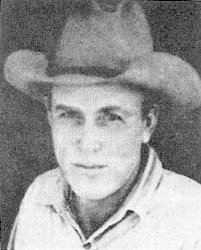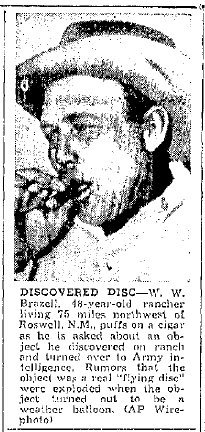Robin Adair(Robin ADAIR, Robin D. ADAIR). |
|
Please, before asking any question or sending any comment or criticism, read this.
According to researcher Donald Schmitt, Robin D. Adair was an Associated Press "wire" man based in Albuquerque, NM, who was sent by the news agency office in New York to report on the "recovered disc" incident near Roswell. There he met with reporter Jason Kellahin, also sent by the Associated Press.
AP told them to get there as fast as possible and they used a rented plane to land at the Roswell municipal airport. But before landing in Rowell, they flew above what Rowell investigators said was the crash site.
In 2017 could verify Robin D. Adair's bio in the archive "Obituaries" of the Albuquerque Journal newspaper website:
|
Adair -- Robin D. Adair was born on August 17, 1901, in Texas. Robin passed away on January 26, 1999, while in the Albuquerque Manor Nursing Home. Mr. Adair is survived by two sons, Robin D. Adair, Jr. living in Westminster, Colorado, and Richard Weldon Adair living in Boulder, Colorado. Mr. Adair was employed by the Associated Press for approximately 40 years, starting on 8-31-24. His last position was as Traffic Bureau Chief in the Albuquerque office of the AP. He retired from the AP on 9-1-66. [...] |
Source:
There is no affidavit by Robin D. Adair.
I found no verbatim full interview or statements by Robin D. Adair.
Researcher Kevin Randle opened his "Roswell Encyclopedia" with pages about Robin D. Adair including context information and statements:
He said that he was in a plane to go to Roswell when he overflew a site surrounded by policemen, F.B.I. people, military officers. These people were waving at their plane to go away, they were afraid of being shot at so they did not dare to fly to close and too low and he could not take pictures of the site.
Adair said he did look at the site and that he "made out a lot of stuff". It looked like a burned place, a gouge and tracks on the ground, and one could tell "something had been there."
He said:
"You couldn't see them too good from the air... apparently the way it cut into [the ground], whatever hit the ground, wasn't wood or something soft. It looked like it was metal."
He said he did not think it "skipped" as it hit the ground, but that it gave the impression of having come down flat "right straight down and straight back up when it left".
Adair said he saw two other "sites", one not very distinctive and the other plainer.
Landing at Roswell, he met with Jason Kellahin, and in the evening they went at the office of the Roswell Daily Record and sent photographs and the story written by Kellahin over the telephone lines.
Source:
The researchers say Robin Adair was a photographer with the Associated Press who received a phone call from the main office in New York on July 8, 1947, asking him to immediately go to Roswell "even if it meant leasing a plane" from the journey from El Paso, Texas.
Adair told the pilot of the plane to fly north toward Lincoln County before landing in Roswell so that he could get aerial shots.
Adair told these researchers that they could not get any pictures, that the place was surrounded by policemen and F.B.I people, and military officers waving them not to approach, so that they were afraid to be shot at and obeyed.
From the air, he saw many troops, vehicles and MP's covering a large open field, with areas that appeared to have been scorched. Despite the altitude the plane was flying, he distinguished a "gouge" and noted that whatever hit the ground was not soft and was not wood, it gave the impression that it descended, hit the ground and then "ascended back into the air".
Heading south to Roswell, he noted the terrain became more rugged and canyon-like, and that the pilot continued to look for military activity on the ground, said that he saw two other recovery sites, one that "wasn't very distinct" and one that was more easily seen.
After landing at the Rowell municipal airstrip West of Roswell, Adairt joined Jason Kellahin, also sent by the New York office of the AP, and who came there by driving from Albuquerque.
In the evening the team went to the Roswell Daily Record office where Adair set up the equipment to transmit to Albuquerque by wire.
The two planned to interview "Mac" Brazel who was now rectracting his original statement that what he found was not a weather balloon. Adair took Brazel's picture and it was sent by wire with the report by Kellahin. The Roswell Daily Record published a photo on July 9 showing Brazel, Adair and Kellahin, because the sending of Brazel's photo by a telephone line was a world premiere.
Source:
This researcher published about Robin Adair and Jason Kellahin on his blog in 2008.
He says he interviewed Jason Kellahin in January, 1993, in his home in Santa Fe. The interview was videotaped.
He says ten months later he was interviewed by [skeptical] researcher Karl Pflock and his story had changed radically from that first interview. Pflock made him sign an affidavit that was [not] published in Karl's book about Roswell.
From Kevin Randle's interview we learn that Kellahin said about Adair:
Adair was with him, he had a camera and took some pictures of the stuff lying on the ground and of the rancher who was there. "Brazel was there and he [Adair] took his picture."
To Pflock and for his affidavit Kellahin said: "Adair and I, Brazel, and the Army men then drove down to Roswell, traveling separately. Late that afternoon or early evening, we met at the offices of the Roswell Daily Record, the city's afternoon newspaper. The military men waited on the sidewalk out front, while I and a Record reporter named Skeritt interviewed Brazel and Adair took his picture. Walter E. Whitmore, owner of KGFL, one of Roswell's two radio stations, was also present during the interview. Whitmore did his best to maneuver Brazel away from the rest of the press."
(Kellahin's testimony to Pflock was essentially that the so called "crashed disc" was just a weather balloon.)
Kevin Randle discusses his interviews of Adair et Kellahin and criticism by Pflock and Klass about it, and notes that indeed, both men cannot be right about the circumstances and that he now suspects that neither are, essentially because once Kellahin and Adair arrived in Roswell, General Ramey had already introduced the balloon explanation. They cannot be both right also because one said it was a balloon and the other said it was a crashed spacecraft.
He specifies that he did not interview Robin Adair himself but worked from the notes and transcripts of the interview conducted by Don Schmitt.
Skeptic researcher "CDA" comments on Randle's blog that "Kellahin's testimony, and his affidavit, are both highly dubious. If he had been at the ranch his article on July 9 makes no mention of it. Instead we read that Brazel came to the newspaper office and gave his interview there."
And: "It seems inconceivable that Kellahin would have omitted that he (and Adair) had been to the ranch and seen the various AF officers and police there (to say nothing of the pieces of the 'flying disc'); i.e. the same people and 'balloon' he talks about 45 years later."
Source:
Below: this photograph of "Mac" Brazel on July 8, 1947, in Roswell, was said to have been taken by Robin Adair:

|
Below: in an unidentified newspaper of July 1947, appeared this picture of "Mac" Brazel; which was no doubt taken by Robin Adair, the caption mentioning its transmission by a phone line ("A.P. Wire-photo"):

|
Transcription of the article:
|
DISCOVERED DISC. -- W. W. Brazell [sic], 48 years old rancher, living 76 miles northwest of Roswell, N.M., puffs on a cigar while he is asked about an object he discovered on ranch and turned over to Army intelligence. Rumors that the object was a real "flying disc" were explosed when the object turned out to be a weather balloon. (A.P. Wire-photo) |